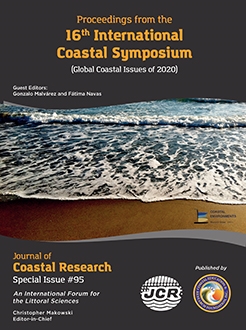Diniz, M.T.M.; Silva, D.S.; Santos, J.R.; Souza, R.M., and Silva, J.P., 2020. Variation of the coastline between the years of 1984 and 2017 in the State of Sergipe, Northeast Region, Brazil. In: Malvárez, G. and Navas, F. (eds.), Global Coastal Issues of 2020. Journal of Coastal Research, Special Issue No. 95, pp. 458–462. Coconut Creek (Florida), ISSN 0749-0208.
The variation of the coastline has become one of the most significant issues for urbanized coastlines in the world, being considered a problem for society, due to the occurrence of erosion in beaches occupied by men. In Brazil, there is a predominant tendency for beach erosion. However, on the coast of the State of Sergipe, Northeast Region in Brazil, dynamic stability predominates in most beaches. The coast in Sergipe has sandy beaches, exposed to the ocean and they are interrupted by the river mouths. The objective of this paper was mapping and presenting the dynamic evolution of the Sergipe coastline between 1984 and 2017, in order to identify areas of erosion, accretion and dynamic stability. The delimitation of the coastline was performed in November 2017 using the Trimble R6 geodetic GPS, the PPK (post-processed kinematic) positioning techniques were applied. The current coastline was compared to another, drawn from 1984 Landsat satellite images, with a spatial resolution of 30 m, sectors where erosion or accretion occurred were delimited. Areas with 30 meters of variation or less were considered dynamically stable, their variation may be related to the resolution of the image from 1984. The mapped coastline has 152, 3 km of linear extension, from which 6, 8 km are river mouths. From the remaining 145, 5 km, 52, 2 km or 34% are subject to erosion, 79, 4 km or 52% are in dynamic stability and 13, 8 km or 9% are in a progradation system. Part of the erosion area is occupied by villages. These findings will help governors and concerned parties to develop strategies for adaptation against losing stretches of land.





